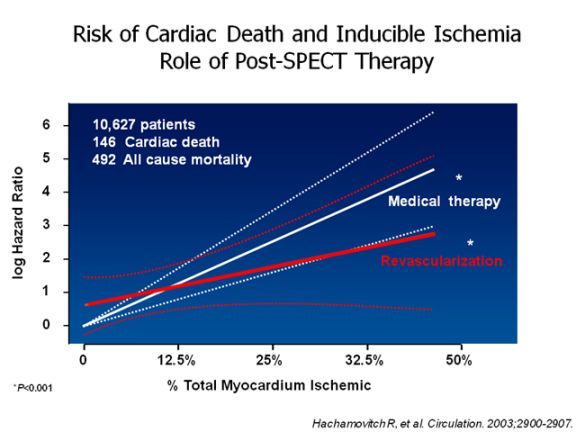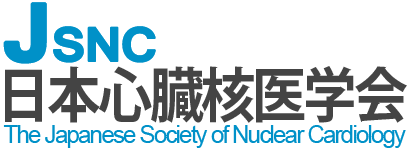要点
|
- 冠動脈疾患治療の目的は、生活の質(QOL)の向上と長期予後の改善である。本疾患におけるQOLとは胸痛などの症状の軽減であり、長期予後の改善を期待して血行再建または内科的治療が選択されることになる。
- 血行再建によるQOLと予後の改善効果は主として症状があり高度の冠動脈狭窄を伴う患者において有効と考えられる。その理由は、血行再建が急性冠症候群の半分以上の原因となっている脆弱性プラーク破裂を予防できないからである。
- 血行再建、内科的療法の治療法選択には心筋血流SPECTによって定量される負荷(運動負荷または薬物負荷)によって誘発された可逆的虚血心筋量の大小が重要であり、虚血心筋量が左心室全体の10%を越える症例では冠血行再建術の予後改善効果が内科的治療を上回る。図および文献 [1]

- Courage研究は、安定型狭心症患者を至適内科的療法でフォローした場合と血行再建後に至適内科的療法でフォローした場合の心事故(心臓死、心筋梗塞発症率など)に差がないことを明らかにした。またSPECTを用いた血行再建と内科的療法後の可逆的虚血心筋量を定量化では、虚血心筋量の低減効果は血行再建群に高く、治療による5%以上の虚血心筋の低減が患者予後改善の指標であるとされる。[2-3]
- 注意点として左冠動脈主幹部病変(LMT病変)においてはSPECTによる虚血心筋量が過小評価されることがあるため注意が必要である。[4]
参考論文
- Hachamovitch R, Hayes SW, Friedman JD, Cohen I, Berman DS, et al. Comparison of the short-term survival benefit associated with revascularization compared with medical therapy in patients with no prior coronary artery disease undergoing stress myocardial perfusion single photon emission computed tomography. Circulation. 2003; 107: 2900-2907.
- Boden WE, O'Rourke RA, Teo KK, Hartigan PM, Maron DJ, Kostuk WJ, et al. Optimal medical therapy with or without PCI for stable coronary disease. N Engl J Med. 2007; 356: 1503-16.
- Shaw LJ, Berman DS, Maron DJ, Mancini GB, Hayes SW, Hartigan PM, et al. Optimal medical therapy with or without percutaneous coronary intervention to reduce ischemic burden: results from the Clinical Outcomes Utilizing Revascularization and Aggressive Drug Evaluation (COURAGE) trial nuclear substudy. Circulation. 2008; 117: 1283-1291.
- Berman DS, Kang X, Slomka PJ, Gerlach J, de Yang L, Hayes SW, et al Underestimation of extent of ischemia by gated SPECT myocardial perfusion imaging in patients with left main coronary artery disease. J Nucl Cardiol. 2007; 14: 521-8.
[NM: 2010.08.01]









